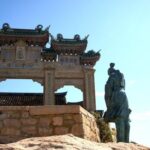The term ‘receiving officials’ implies an aspiration for success in the imperial examinations. There is a couplet in the pavilion that reads, ‘Famous masters leave wonders, and strange craftsmen amuse passers-by.’ Also known as the Flower Pavilion because it is located by the lotus pond at the southern end of Lishui Street in Yantou. Jieguanting was built in 1556, the 35th year of Jiajing in the Ming Dynasty. There are four pillars inside and four pillars outside the pavilion. The top plane is a square double-eaved pyramidal roof. Five layers of brackets are stacked to form an octagonal caisson, implying the five elements and eight trigrams. The eight ridges of the double-eaved roof each have a statue of ‘Zhang Guolao riding a white donkey’. The ridge ends are sculpted with the pattern of ‘Liu Hai presenting money’. The structure is tight and the appearance is simple. At the southern end of Lishui Street is the south gate of the stockade wall. There is Chengfeng Pavilion on the high steps beside the gate. Less than 50 meters away from the pavilion, there is another Jieguanting (also known as the Flower Pavilion), with a double-eaved pyramidal roof, simple and solemn. Open all year round and all day.
Jieguanting Posthouse
The term ‘receiving officials’ implies an aspiration for success in the imperial examina[...]









